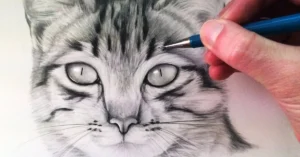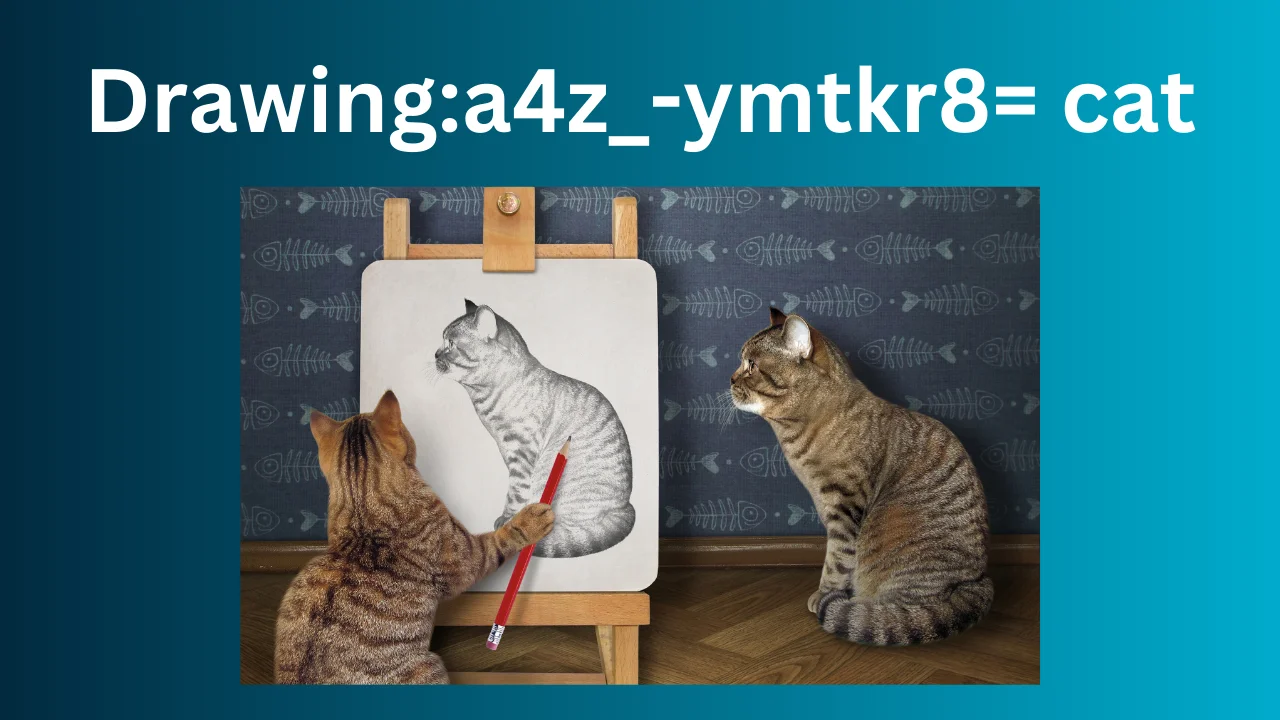Drawing:a4z_-ymtkr8= cat hints at an intriguing exploration of cat-themed drawings, a topic that captivates artists of all levels. Cats, with their graceful movements, expressive eyes, and unique personalities, are a fascinating subject to sketch. Whether you’re a beginner honing your skills or a seasoned artist refining your craft, drawing cats offers a blend of simplicity and complexity that can elevate your artistic abilities.
Why Cats Are a Favorite Subject for Drawing
Drawing:a4z_-ymtkr8= cat have been a muse for artists throughout history. Their sleek fur, fluid movements, and distinctive features make them an engaging challenge. A cat’s posture can convey a range of emotions, from serenity to playful curiosity, which is why they are ideal for practicing dynamic poses. Additionally, their anatomy, with elongated limbs, elegant tails, and delicate facial features, allows artists to experiment with lines, shading, and texture.
Drawing:a4z_-ymtkr8= cat is a great way to study anatomy without getting too bogged down in complexity. Their bodies follow simple yet elegant shapes – circles for heads, long curves for tails – making them approachable for beginners. Yet, capturing their essence requires an eye for detail and an understanding of motion, which challenges even experienced artists.
Tools and Techniques for Drawing Cats
- Pencil Sketching: Start with basic pencil sketches. Using light strokes, outline the head, body, legs, and tail. Focus on the proportions and position of each element, and add details like eyes, ears, and whiskers as you refine the sketch. Drawing:a4z_-ymtkr8= cat are known for their sleek lines and curves, so keeping your strokes fluid helps in achieving a natural look.
- Shading: Once the sketch is complete, shading is where you can bring life to the drawing. Pay attention to the light source and apply different levels of shading to create depth and texture. Cats’ fur can be smooth or fluffy, and shading is the key to capturing these variations.
- Digital Art: For those inclined towards digital drawing, a stylus and drawing tablet offer a range of brushes and textures that mimic real-life media. You can experiment with layers, different fur patterns, and digital lighting to create a dynamic image of a cat.
- Cartoon Cats: Drawing:a4z_-ymtkr8= cat cartoon versions of cats is a fun way to express their playful nature. Exaggerate their large eyes, paws, and quirky expressions to create a character full of personality. This technique is great for developing your sense of proportion and for adding a whimsical touch to your work.
Practice Makes Perfect
Like with any art form, practice is essential when drawing cats. Start by observing real cats or reference photos to understand their movements and features. Try drawing cats in various poses, such as sitting, stretching, or jumping. Each posture offers new challenges and helps improve your ability to capture motion.
Once you’re comfortable with basic sketches, experiment with different styles, such as realism, impressionism, or even abstract forms. Each style allows you to interpret the essence of a cat in a unique way, broadening your artistic horizons.
Expanding Your Artistic Skills Through Cat Drawing
As you continue to practice and refine your Drawing:a4z_-ymtkr8= cat skills, you’ll naturally develop an enhanced sense of observation and a deeper understanding of animal anatomy. Drawing cats isn’t just about replicating their appearance—it’s about capturing their personality, which can be particularly tricky due to their complex, often aloof demeanor. But the more you study and draw cats, the more you’ll notice the subtle details that make each one unique.
Going Beyond the Basics: Advanced Techniques
 Once you feel confident with the basics of Drawing:a4z_-ymtkr8= cat, consider exploring more advanced techniques to challenge yourself and elevate your work:
Once you feel confident with the basics of Drawing:a4z_-ymtkr8= cat, consider exploring more advanced techniques to challenge yourself and elevate your work:
- Action Poses: Drawing cats in action—whether they’re leaping, hunting, or playing—can add dynamism to your art. Capturing the fluidity and speed of their movements requires quick, loose strokes. Gesture drawing is an excellent exercise for this. It allows you to sketch the overall movement of a cat without worrying too much about details, helping you capture the essence of their action.
- Focus on Eyes and Expression: Cats are known for their piercing eyes, which often seem to hold a world of emotion. Paying close attention to the details of a cat’s eyes can take your drawing to the next level. The shape, size, and shine in the eyes are crucial in conveying a cat’s mood—whether it’s curiosity, contentment, or mischief. Consider experimenting with different eye styles to evoke a variety of emotions in your feline subjects.
- Texturing Fur: Realistic fur can be a challenge, especially when it comes to long-haired cats. Layering your pencil strokes, or using digital brushes that mimic fur, helps build up the texture. Remember to follow the direction of the fur and vary the pressure on your pencil or stylus to create depth and realism. Short-haired cats require smoother, lighter strokes, while fluffy cats need a combination of fine lines and broad strokes to mimic the density of their coats.
- Exploring Mediums: Don’t limit yourself to pencil and paper. Experiment with different mediums, such as charcoal for dramatic, bold sketches or watercolors for soft, dreamy depictions of cats. Colored pencils or pastels are great for adding life and vibrancy to your drawings, allowing you to capture the wide variety of colors and patterns in feline fur.
- Background and Environment: Once you’re comfortable drawing the cat itself, consider incorporating a background or environment to provide context to your Drawing:a4z_-ymtkr8= cat. A lounging cat on a windowsill, a prowling cat in a garden, or a playful kitten surrounded by toys can turn your sketch into a more complete artwork. The setting can also be an opportunity to work on additional artistic skills, such as perspective and composition.
Finding Inspiration
If you find yourself needing a spark of inspiration, the world of cats is vast and diverse. From majestic lions to playful house Drawing:a4z_-ymtkr8= cat, cats come in all shapes, sizes, and breeds, each with unique characteristics. Some sources of inspiration include:
- Reference Images: Use photo references from cat photography books or online platforms to study different cat breeds. Maine Coons, Siamese, and Sphynx cats, for example, offer a wide range of textures and body shapes to explore in your art.
- Real-life Observation: If you have a pet cat, or access to one, observing them in their daily routine can offer endless drawing opportunities. Watching how a cat curls up to sleep, stretches lazily, or pounces on a toy can provide you with natural, spontaneous poses to capture.
- Famous Felines in Art: Throughout history, cats have appeared in famous paintings, sculptures, and even street art. Look to artists like Leonardo da Vinci, who famously sketched cats, or modern artists who incorporate cats into their surreal or abstract works. Studying how other artists interpret cats can give you ideas for your own style.
Final Thoughts
While there are many tips and techniques to help you improve, the beauty of drawing lies in personal expression. Drawing:a4z_-ymtkr8= cat you’re free to experiment, make mistakes, and discover your own unique approach to illustrating these enchanting creatures. Don’t be afraid to break the rules—whether that means using bold, exaggerated shapes, or adding abstract elements to your cat drawings.
As you continue your artistic journey, your Drawing:a4z_-ymtkr8= cat will evolve with you, reflecting your growth as an artist. The process of drawing cats can be as relaxing or as challenging as you make it, and it’s a wonderful subject to keep coming back to, each time with a fresh perspective and a more refined skillset.
In the end, drawing cats isn’t just about the result—it’s about the joy of creation, the learning experience, and the connection you form with your subject. Let each sketch be a reflection of your personal interpretation of the beauty and grace of these remarkable animals.
Also Read: Tartan High School Ann Bacon













Leave a Reply